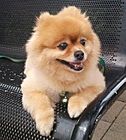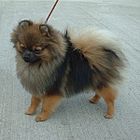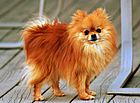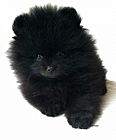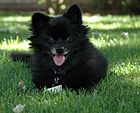Pomeranian dog facts for kids
 |
|||||||||||||||||
| Other names | Deutscher Spitz, Zwergspitz, Dwarf Spitz |
||||||||||||||||
|---|---|---|---|---|---|---|---|---|---|---|---|---|---|---|---|---|---|
| Common nicknames | Pom Dog, Pom-Pom, Pom, Zwers, Tumbleweed |
||||||||||||||||
| Origin | Pomerania | ||||||||||||||||
|
|||||||||||||||||
|
|||||||||||||||||
| Domestic dog (Canis lupus familiaris) | |||||||||||||||||
The Pomeranian, often called a Pom, is a small, fluffy dog breed. It's named after the Pomerania region in Central Europe, which is now part of Poland and Germany. These dogs are part of the Spitz family, which includes dogs with thick fur and pointed ears. Pomeranians are known as "toy dogs" because they are so small. They actually come from much larger Spitz dogs, like the German Spitz. In many countries, they are even called Zwergspitz, which means "Dwarf Spitz".
Pomeranians became very popular thanks to royal owners starting in the 1700s. Queen Victoria owned a tiny Pomeranian, which made smaller Poms fashionable. During her life, the breed's size was cut in half! Overall, Pomeranians are strong and healthy dogs. Some common health issues they might face are problems with their kneecaps (called luxating patella) and a weak windpipe (tracheal collapse). Rarely, they can get a skin condition called Alopecia X, also known as "black skin disease," which causes their skin to turn black and they lose most of their hair. Since the late 1990s, Pomeranians have been one of the top 50 most popular dog breeds in the United States. Their small size has made them even more popular around the world.
Contents
What Pomeranians Look Like
Pomeranians are small dogs, usually weighing between 1.36 and 3.17 kilograms (3 to 7 pounds). They stand about 20 to 36 centimeters (8 to 14 inches) tall at the shoulder. They are sturdy dogs with a lot of fluffy fur and a tail that curls up high over their back. Their top coat forms a thick "ruff" of fur around their neck, which is a famous feature of Poms. They also have feathery fur on their back legs.
The first Pomeranians were often white, or sometimes brown or black. In 1888, Queen Victoria got a small red Pomeranian. This made the red color very popular by the end of the 1800s. Today, Pomeranians come in more colors than almost any other dog breed! You can find them in white, black, brown, red, orange, cream, blue, sable, black and tan, brown and tan, spotted, brindle, and even "parti" (which means they have patches of different colors). The most common colors are orange, black, or cream/white.
A newer color pattern is the "merle" Pomeranian. This is when a solid color dog has lighter blue or grey patches, making a mottled look. The most common merle colors are red/brown or black, but it can happen with other colors too. Merle Pomeranians often have blue eyes, and their nose and paw pads can be pink and black.
Pomeranians have a thick double coat. Even though grooming isn't too hard, it's best to brush them every day to keep their fur nice. They shed a lot, especially twice a year when their undercoat changes. Their fur can get tangled easily, so regular brushing helps a lot.
Pomeranian Behavior
Pomeranians are usually friendly, lively, and playful dogs. They can sometimes try to be bossy with other dogs or even people. Poms are very alert and notice changes around them. They might bark a lot at new sounds or sights, which can become a habit. They also like to protect their home, so they might bark when they hear noises outside.
Pomeranians are smart and learn well from training. They can be very good at getting what they want from their owners! They love being the center of attention. However, if they aren't trained and socialized well, they can become stubborn or try to be in charge. Giving them toys can help them learn to be alone sometimes.
Pomeranian Health and Care
Pomeranians usually live for 12 to 16 years. A Pomeranian that is well-fed and gets enough exercise will likely have few health problems. They are quite sturdy dogs if they stay at a healthy weight. While they are generally healthy, they can have some health issues like other dog breeds. For example, hip problems are rare because Poms are so light.
It's important to keep their teeth, ears, and eyes clean to avoid problems. Poms are prone to losing their teeth early, so dry dog food is often recommended. Pomeranians also have small litters, usually having only 1.9 to 2.7 puppies at a time.
Exercise Needs
Even though Pomeranians are small, they are energetic dogs. They love getting lots of attention. However, they don't need a huge amount of exercise. It's a good idea to take them for several short walks each day. They also enjoy running around in a safe, enclosed area.
History of the Pomeranian
Where Pomeranians Came From
The Pomeranian breed is believed to have come from the German Spitz. The breed got its name from the Pomerania region, which is along the Baltic Sea in northern Poland and Germany. This area is where the original Pomeranian type of dog was developed, even though the breed didn't actually start there. We don't have many written records until the breed came to the United Kingdom.
One of the first mentions of the Pomeranian breed was in a diary entry from November 2, 1764, by James Boswell. He wrote about a Frenchman who had a Pomeranian dog named Pomer.
Two queens from the British royal family helped make the breed popular. In 1767, Queen Charlotte, who was married to King George III, brought two Pomeranians to England. These dogs, named Phoebe and Mercury, were painted by Sir Thomas Gainsborough. The paintings show dogs that were much larger than today's Poms, weighing up to 13 to 23 kilograms (30 to 50 pounds). But they still had the thick fur, pointed ears, and curled tail that Pomeranians are known for.
Queen Victoria, who was Queen Charlotte's granddaughter, also loved Pomeranians. She had a large kennel for breeding them. One of her favorite dogs was a small red sable Pomeranian named "Windsor's Marco," who weighed only about 5.4 kilograms (12 pounds). When she showed Marco in 1891, smaller Pomeranians became instantly popular. Breeders then started choosing only the smallest dogs for breeding. Because of Queen Victoria, the size of the Pomeranian breed became 50% smaller during her lifetime. She brought smaller Pomeranians of different colors from other European countries to help her breeding program. Other royal owners included Joséphine de Beauharnais, who was married to Napoleon I of France, and King George IV of the United Kingdom.
The first club for the Pomeranian breed was started in England in 1891. Soon after, the first rules for the breed were written down. The first Pomeranian was registered in the United States with the American Kennel Club in 1898, and the breed was officially recognized in 1900.
In 1912, two Pomeranians were among only three dogs that survived when the RMS Titanic sank! A Pomeranian named "Lady" escaped with her owner in lifeboat number seven. Another Pomeranian was taken to safety by Elizabeth Barrett Rothschild in lifeboat number six.
A Pomeranian named Glen Rose Flashaway won the Toy Group at the Westminster Kennel Club Dog Show in 1926. This was the first Pomeranian to win a group at this famous show. It wasn't until 1988 that a Pomeranian, "Great Elms Prince Charming II," won the top prize, "Best in Show," at the Westminster Kennel Club.
Today, the Pomeranian is part of the German Spitz standard set by the Fédération Cynologique Internationale. This standard says that "Spitz breeds are captivating" and have a "unique, cheeky appearance."
How Popular Are Pomeranians?
The Pomeranian has been a very popular dog breed in the United States. It has been in the top 20 most registered breeds with the American Kennel Club since at least 1998. In 2017, it was ranked #22.
While not in the top 20 in the UK in 2007 or 2008, their popularity in Australia has gone down since 1986. However, it has increased a bit since 2004. Pomeranians are also quite popular in American cities. In 2008, they were joint tenth in Detroit and Orlando, ninth in Los Angeles, and third in Honolulu. They are known as the 27th most intelligent dog breed.
See also
 In Spanish: Pomerania (perro) para niños
In Spanish: Pomerania (perro) para niños


